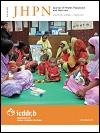Sex Differences Independent of Other Psycho-sociodemographic Factors as a Predictor of Body Mass Index in Black South African Adults
DOI:
https://doi.org/10.3329/jhpn.v30i1.11277Keywords:
Body mass index, Body-weight, Cross-sectional studies, Gender, Overweight, Obesity, Sex difference, South AfricaAbstract
To better understand the sex differences in body mass index (BMI) observed in black South African adults in the Transition and Health during Urbanization of South Africans Study, the present study investigated whether these differences can be explained by the psycho-sociodemographic factors and/or health-related behaviours. A cross-sectional survey was undertaken among 1,842 black South African individuals from 37 study sites that represented five levels of urbanization. The behavioural factors that possibly could have an influence on the outcome of body-weight and that were explored included: diet, smoking, level of education, HIV infection, employment status, level of urbanization, intake of alcohol, physical activity, and neuroticism. The biological factors explored were age and sex. The prevalence of underweight, normal weight, and overweight among men and women was separately determined. The means of the variables were compared by performing Students t-test for normally-distributed variables and Mann-Whitney Utest for non-normally-distributed variables. The means for the underweight and overweight groups were tested for significant differences upon comparison with normal-weight individuals stratified separately for sex. The differences in prevalence were tested using chi-square tests (p<0.05). All the variables with a large number of missing values were tested for potential bias. The association between sex and underweight or overweight was tested using the Mantel-Haenszel method of odds ratio (OR) and calculation of 95% confidence interval (CI), with statistical significance set at p<0.05 level. Logistic regression was used for controlling for confounders and for testing for effect modification. Females were more likely to be overweight/obese (crude OR=5.1; CI 3.8-6.8). The association was attenuated but remained strong and significant even after controlling for the psycho-sociodemographic confounders. In this survey, the risk for overweight/obesity was strongly related to sex and not to the psycho-sociodemographic external factors investigated. It is, thus, important to understand the molecular roots of sex- and gender-specific variability in distribution of BMI as this is central to the future development of treatment and prevention programmes against overweight/obesity.
DOI: http://dx.doi.org/10.3329/jhpn.v30i1.11277
J HEALTH POPUL NUTR 2012 Mar;30(1):56-65
Downloads
347
236

